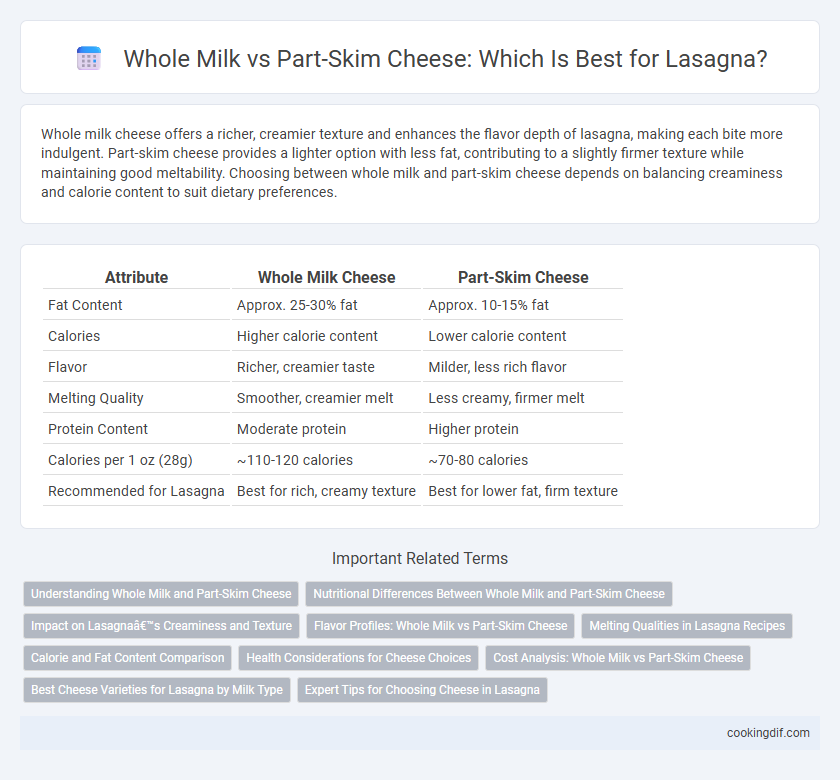Whole milk cheese offers a richer, creamier texture and enhances the flavor depth of lasagna, making each bite more indulgent. Part-skim cheese provides a lighter option with less fat, contributing to a slightly firmer texture while maintaining good meltability. Choosing between whole milk and part-skim cheese depends on balancing creaminess and calorie content to suit dietary preferences.
Table of Comparison
| Attribute | Whole Milk Cheese | Part-Skim Cheese |
|---|---|---|
| Fat Content | Approx. 25-30% fat | Approx. 10-15% fat |
| Calories | Higher calorie content | Lower calorie content |
| Flavor | Richer, creamier taste | Milder, less rich flavor |
| Melting Quality | Smoother, creamier melt | Less creamy, firmer melt |
| Protein Content | Moderate protein | Higher protein |
| Calories per 1 oz (28g) | ~110-120 calories | ~70-80 calories |
| Recommended for Lasagna | Best for rich, creamy texture | Best for lower fat, firm texture |
Understanding Whole Milk and Part-Skim Cheese
Whole milk cheese contains higher fat content, enhancing the creamy texture and rich flavor that elevates lasagna's overall taste profile. Part-skim cheese offers reduced fat levels, providing a lighter option while maintaining sufficient meltability and stretch for layered pasta dishes. Choosing whole milk or part-skim cheeses affects both nutritional values and the optimal balance of moisture and flavor in lasagna recipes.
Nutritional Differences Between Whole Milk and Part-Skim Cheese
Whole milk cheese contains higher fat content, typically around 25-30%, contributing to a richer texture and creamier taste in lasagna, while part-skim cheese offers reduced fat levels, generally below 10%, promoting a lower calorie option. Protein content remains relatively similar in both varieties, but part-skim cheese provides a leaner alternative beneficial for heart health and weight management. Choosing between whole milk and part-skim cheese can significantly influence the overall nutritional profile of lasagna, impacting fat intake and calorie density.
Impact on Lasagna’s Creaminess and Texture
Whole milk cheese enhances lasagna's creaminess by contributing higher fat content, resulting in a richer, smoother texture that melts evenly throughout layers. Part-skim cheese offers a lighter texture with less fat, producing a firmer consistency but potentially sacrificing some of the traditional lushness. Choosing whole milk cheese intensifies the dish's indulgent mouthfeel, while part-skim provides a leaner option that impacts the lasagna's texture with slightly reduced creaminess.
Flavor Profiles: Whole Milk vs Part-Skim Cheese
Whole milk cheese delivers a richer and creamier flavor in lasagna, enhancing the dish with its higher fat content and smooth texture. Part-skim cheese offers a lighter taste and firmer consistency, allowing the tomato sauce and spices to stand out more prominently. Choosing between whole milk and part-skim cheese impacts the overall balance of richness and tanginess in the final lasagna.
Melting Qualities in Lasagna Recipes
Whole milk cheese offers superior melting qualities in lasagna recipes due to its higher fat content, creating a creamier, richer texture that enhances the dish's overall mouthfeel. Part-skim cheese melts less uniformly and can result in a slightly rubbery or grainy texture, impacting the smoothness of the cheese layer. Selecting whole milk cheese ensures optimal meltability and flavor integration, ideal for achieving the traditional, luscious consistency of classic lasagna.
Calorie and Fat Content Comparison
Whole milk cheese contains approximately 6-9 grams of fat and 80-110 calories per ounce, offering a richer, creamier texture ideal for lasagna. Part-skim cheese typically has 3-5 grams of fat and 50-70 calories per ounce, making it a lower-fat, lower-calorie option that still provides adequate meltability. Choosing part-skim cheese can reduce overall calorie and fat content in lasagna without sacrificing too much flavor or texture.
Health Considerations for Cheese Choices
Whole milk cheese contains higher levels of saturated fat and calories compared to part-skim cheese, which may impact heart health when consumed in excess. Part-skim cheese offers a lower fat alternative while still providing essential nutrients like calcium and protein, making it a healthier option for lasagna recipes. Choosing part-skim cheese helps reduce overall saturated fat intake without sacrificing flavor or texture in the dish.
Cost Analysis: Whole Milk vs Part-Skim Cheese
Whole milk cheese generally costs more than part-skim cheese due to higher fat content and creaminess factors affecting production expenses. Part-skim cheese offers a more budget-friendly option while maintaining adequate flavor and melting properties essential for lasagna. Evaluating cost per pound reveals part-skim varieties can reduce overall ingredient spending without compromising dish quality.
Best Cheese Varieties for Lasagna by Milk Type
Whole milk cheese varieties like whole milk mozzarella and ricotta provide a rich, creamy texture and full-bodied flavor ideal for traditional lasagna recipes. Part-skim cheeses such as part-skim mozzarella maintain a lighter fat content while still offering good meltability and structure, suitable for a healthier lasagna option. Choosing whole milk or part-skim cheese depends on balancing richness and calorie content, with whole milk cheeses enhancing flavor depth and part-skim cheeses delivering a lower-fat alternative.
Expert Tips for Choosing Cheese in Lasagna
Whole milk cheese provides a richer, creamier texture and a more robust flavor ideal for authentic, indulgent lasagna, while part-skim cheese offers a lighter option with reduced fat but a firmer texture that holds well during baking. Experts recommend balancing whole milk and part-skim cheeses to achieve optimal meltability and flavor complexity, for example, combining whole milk mozzarella with part-skim ricotta. Choosing cheeses with higher moisture content enhances the creamy layers, whereas lower moisture cheeses contribute to structural integrity, ensuring the lasagna remains cohesive after baking.
Whole milk vs Part-skim for cheese Infographic

 cookingdif.com
cookingdif.com